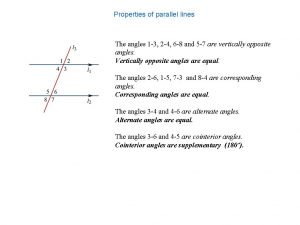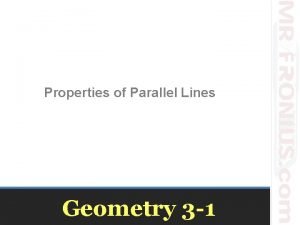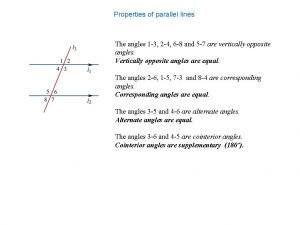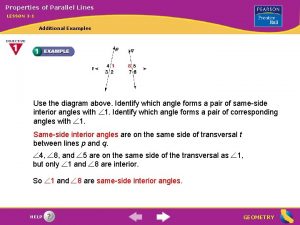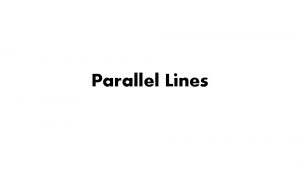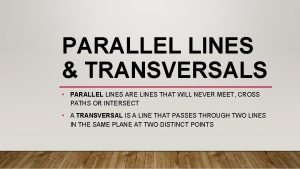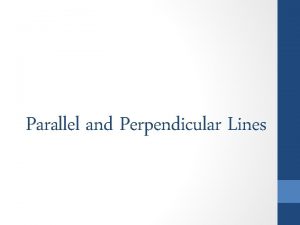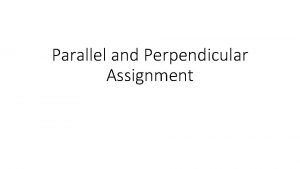Properties of Parallel Lines LESSON 3 1 Additional






- Slides: 6

Properties of Parallel Lines LESSON 3 -1 Additional Examples Use the diagram above. Identify which angle forms a pair of same-side interior angles with 1. Identify which angle forms a pair of corresponding angles with 1. Same-side interior angles are on the same side of transversal t between lines p and q. 4, 8, and 5 are on the same side of the transversal as but only 1 and 8 are interior. So HELP 1 and 1, 8 are same-side interior angles. GEOMETRY

Properties of Parallel Lines LESSON 3 -1 Additional Examples (continued) Corresponding angles also lie on the same side of the transversal. One angle must be an interior angle, and the other must be an exterior angle. The angle corresponding to 1 must lie in the same position relative to line q as 1 lies relative to line p. Because 1 is an interior angle, 1 and are corresponding angles. 5 Quick Check HELP GEOMETRY

Properties of Parallel Lines LESSON 3 -1 Additional Examples Compare 2 and the vertical angle of 1. Classify the angles as alternate interior angles, same-side interior angles, or corresponding angles. The vertical angle of 1 is between the parallel runway segments. 2 is between the runway segments and on the opposite side of the transversal runway. Because alternate interior angles are not adjacent and lie between the lines on opposite sides of the transversal, 2 and the vertical angle of 1 are alternate interior angles. Quick Check HELP GEOMETRY

Properties of Parallel Lines LESSON 3 -1 Additional Examples Use the given that a b and the diagram to write a two-column proof that 1 and 4 are supplementary. Statements Reasons 1. a b 1. Given 2. m 1 = m 3 2. Corresponding Angles Postulate 3. m 3 + m 4 = 180 3. Angle Addition Postulate 4. m 1 + m 4 = 180 4. Substitution 5. 1 and 4 are supplementary 5. Definition of supplementary angles HELP Quick Check GEOMETRY

Properties of Parallel Lines LESSON 3 -1 Additional Examples In the diagram above, || m. Find m 1 and then m 2. 1 and the 42° angle are corresponding angles. Because m 1 = 42 by the Corresponding Angles Postulate. || m, Because 1 and 2 are adjacent angles that form a straight angle, m 1 + m 2 = 180 by the Angle Addition Postulate. If you substitute 42 for m 1, the equation becomes 42 + m Subtract 42 from each side to find m 2 = 138. 2 = 180. Quick Check HELP GEOMETRY

Properties of Parallel Lines LESSON 3 -1 Additional Examples In the diagram above, || m. Find the values of a, b, and c. a = 65 Alternate Interior Angles Theorem c = 40 Alternate Interior Angles Theorem a + b + c = 180 65 + b + 40 = 180 b = 75 Angle Addition Postulate Substitution Property of Equality Subtraction Property of Equality Quick Check HELP GEOMETRY

